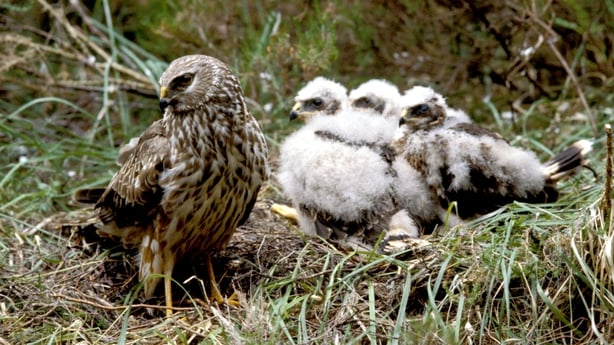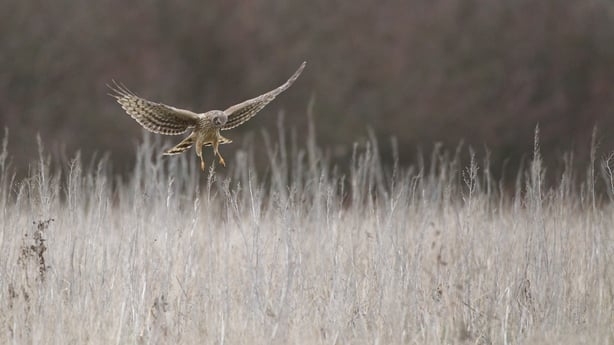Farmers are doing the "heavy lifting" on saving hen harriers, BirdWatch Ireland has said.
In its fifth national survey of the hen harrier population, conducted in 2022, the NPWS found a "maximum of 106 breeding pairs".
It said the number of breeding pairs is between 85 and 106.
There has been a locally-led scheme in place for years to provide financial support to farmers who take action to protect hen harrier populations.
Head of Advocacy at BirdWatch Ireland Oonagh Duggan said while it is fantastic to see that a lot of farmers are working to save the hen harrier, she outlined the need for more long-term support from the Government.
Speaking on RTÉ's Morning Ireland, she said it is one of their recommendations in the 'Save the Skydancer' campaign which they launched yesterday.
Ms Duggan also said the Government's new Hen Harrier Threat Response plan does not deal with the major problems that she said must be addressed.
"That is based on forestry, the forestry removal in the habitat of hen harriers especially for breeding and wintering," Ms Duggan said.
She said hen harriers like open country and nest on the ground in heather, so there are serious problems for them when there is too much forestry.

She said the Government, especially in the forest service, "need to start to knuckle down and commit to plans to remove forestry" in the special protection areas.
"We are running out of time, the species declined by 33% during the time this plan is being made," Ms Duggan said.
She said they sat at the consultative committee and they tried to improve the plan but their hopes have been dashed "despite some good things in it".
"We are at the point where we feel like the Government is quietly quitting on this magnificent bird of prey," Ms Duggan said.
In a statement, the NPWS: "The Hen harrier is one of Ireland's most threatened birds and its conservation is a priority for us all.
"A range of factors have contributed to the situation we now find ourselves in, most notably land use change in the locations where these birds forage and nest.
"The draft Threat Response Plan has been developed over a number of years in close consultation with the many stakeholders who have a role to play in ensuring that we reverse the decline of the amazing Skydancer.
"The best way the public can support that work is by submitting their views on the plan - the public consultation is open until February 20th."
'Our understanding of the land started to change'
Beef farmer Jonathan Blackmore from Croughafoil, Co Limerick, said when he first found out that his upland farm was assigned hen harrier status and would be part of the first five-year Hen Harrier Programme, he thought it was the "death knell" for his farming business.
He said: "We were very uneducated and we didn't know just what it meant. We were in a situation where our land had basically been entombed in this bureaucracy of hen harrier."
However, as Mr Blackmore got involved in the project his outlook began to change, especially after he went to an open evening about the programme.
"I looked at my land, sometimes rushes up to your knees and I just saw this wasteland, this poor, unproductive land ... we started to realise that our land was actually this really biodiverse, rich, very valuable and very worth fighting for," he said.
At first, he and his wife did not say much about the project they were involved in.
"We felt very strange. We weren't doing a conventional farm," Mr Blackmore said.
Instead of looking for productivity and spreading lots of fertiliser, Mr Blackmore was allowing some of his land to flood, they were putting in bird cover and inviting natural pollinators like bees into their farm.

"We were worried," Mr Blackmore said, "kind of anxious about it ... there’s a certain level of not being the same."
Their work paid off not only in terms of a financial return but Mr Blackmore and his wife began to have a new appreciation for their land.
"Our understanding of the land started to change," he said.
Mr Blackmore said: "What we ended up doing was looking at the land use in a in a more productive way in in a better way.
"Instead of trying to increase productivity, what we try to do is reduce our livestock numbers, give them a healthier life with more foraging through this landscape."
Mr Blackmore and his wife went back to farming practices that had gone out of fashion 30 years ago.
He added: "At one level it really did change the way we looked at our farm because when you go up there now on a busy May morning, you've got lots of bees flying around, you've got lots of insect life which had sort of fallen away from our farms or had been driven out through lack of habitat or through poisoning."







